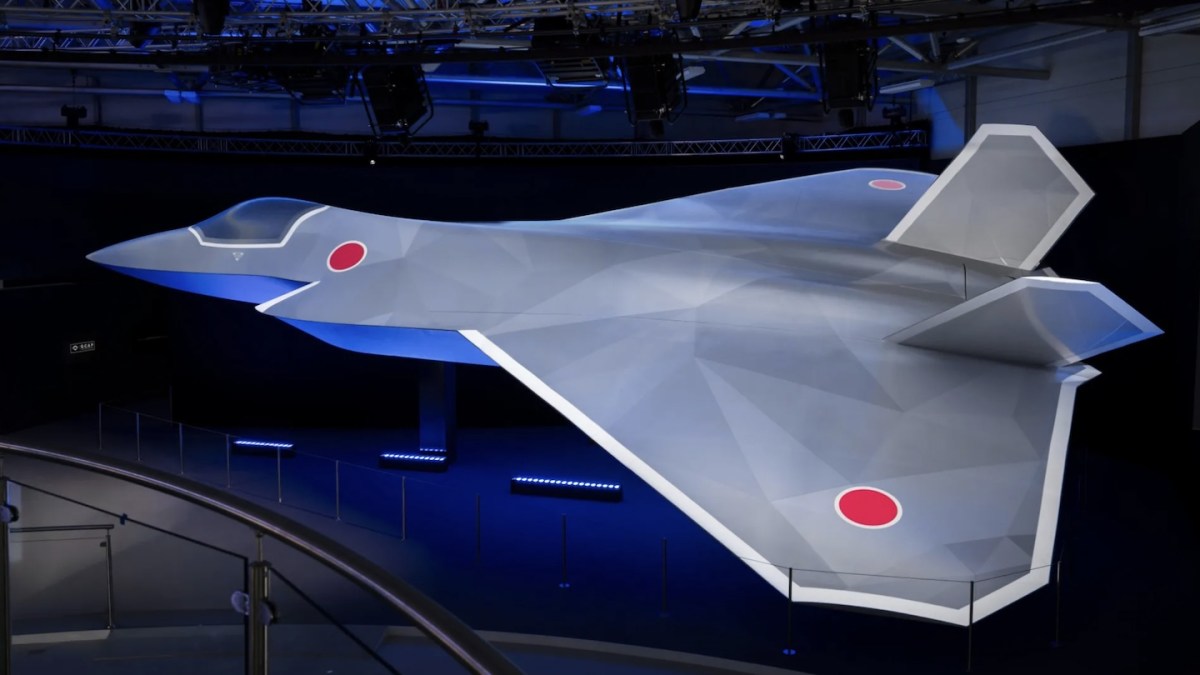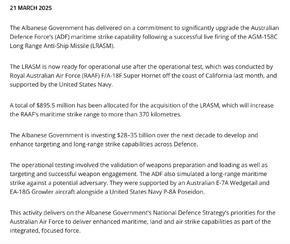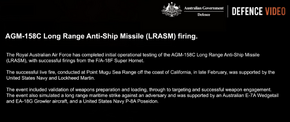A bit of background and some updates on the Ghost Bat program from Flight International (subscription) :
"Local hero
By Greg Waldron Singapore, Flight International
Saturday 1 March 2025 at 12:00:00 am AEDT
The Australian-developed MQ-28 has made swift progress since emerging at the Avalon air show six years ago, with a Block 2 version coming soon and more local suppliers getting on board
Representing a crucial part of Boeing's collaborative combat aircraft (CCA) strategy, the MQ-28 Ghost Bat also stands to enhance Australia's position in the global defence aerospace industry.
The developmental unmanned ‘loyal wingman' is a joint effort between Boeing and the Royal Australian Air Force (RAAF). Four years on from its first flight in February 2021, an improved Block 2 version is in the works, as Boeing Defence Australia invests in the industrial capacity that will be needed should the new jet gain a customer.
The MQ-28 created a stir in 2019 when a full-sized mock-up of what was then called the Airpower Teaming System was unveiled at the Avalon air show. Today, it is a maturing platform in a crowded field of aspiring CCAs. The Ghost Bat is coming of age during a decade that will see the operational concept of the CCA clarified, with automated combat aircraft moving closer to working seamlessly with their manned counterparts.
Glen Ferguson, the director of Boeing's global MQ-28 programme, is well versed in air warfare, having previously spent 17 years in the RAAF, most of it as a navigator in the now-retired General Dynamics F-111 fighter-bomber.
“Once we got through the teething issues of getting the aircraft flying and all the elements with that, we proved out the airframe, and we're largely done with airframe testing,” he says.
Over the past 12-18 months the focus has been on testing mission systems, with an emphasis on electronic warfare (EW) and intelligence, surveillance and reconnaissance (ISR).
This entails integrating and operating payloads, and exploring the aircraft's behaviour in a mission environment. Ferguson stresses, however, that the mission system - and not the MQ-28 platform as such - is the real priority.
“The mission system is probably more important than the airframe,” he said in the run-up to this year's Avalon show, which will be staged near Melbourne from 25-30 March. “In many ways, the airframe becomes the vehicle within which we get the mission system to the fight.”
In other words, the know-how that applies to the MQ-28 could also be applied to other CCAs. This includes the aircraft's ability to generate contacts and then automatically fuse that information with input from other aircraft and sensors.
By earlier this year, the small MQ-28 test fleet had been flown for around 100h, but more than 20,000h of testing had been completed in a digital environment.
“Our mission system is maturing at a rate that I don't think anyone has comprehended in the past, because we are now flying multiple aircraft at a time, including virtual hybrid-live aircraft,” says Ferguson.
“We're running a virtual aircraft so that we can do sensor and data fusion to track operational targets at operationally relevant ranges to deliver the outcome to the air force.”
Operational tests have taken place at Australia's Woomera test range approximately one out of every three months, with the aircraft flying one to three sorties daily, including some flights at night.
The RAAF is heavily involved in the programme, funding ongoing development work and with personnel embedded across MQ-28 operations. Also involved are representatives from the US Air Force (USAF) and US Navy (USN): the first Ghost Bat “pilot” from the latter service graduated from training last year.
The involvement of US personnel on a fundamentally Australian programme is part of a larger collaboration between the two governments on CCAs.
“This gives us the ability to co-ordinate with the US government on where they are going, and the most important part of that is that we get access to their architectures and their plans,” says Ferguson.
“It's all about interoperability and interchangeability. We are developing the MQ-28 to be aligned with US government architectures of the future, so that we are compatible, and an [MQ-28] can turn up at any place in the sky and jump on board with western aircraft.”
Boeing has given the MQ-28's range as 2,000nm (3,700km). Australia's vast geography and the sheer size of the Asia-Pacific region make long-range performance an essential attribute for a CCA operating with the RAAF or other air forces. Another emphasis is collaboration between the unmanned type and Australia's two fighter types: the Boeing F/A-18F Super Hornet and Lockheed Martin F-35A.
Although an MQ-28 was sent to the USA in 2023, ostensibly for work related to the USAF's CCA programme, in July 2024 a USAF down select effectively focused the service's ‘increment one' efforts with two California-based companies: Anduril Industries and General Atomics Aeronautical Systems. Each will receive funding to design and manufacture “production-representative test articles”, and to conduct flight-testing of prototype aircraft.
Boeing, for its part, says the MQ-28 was not part of its offering for the USAF's increment one requirement nor was a variant of the MQ-25 Stingray, which is being developed as an air-to-air refueller for the USN.
“We did not propose the MQ-28 or an MQ-25 derivative for increment one of this programme,” the company confirms. “We proposed another proprietary solution tailored to the US Air Force's unique CCA phase one requirements.”
Alongside the USAF's CCA effort, MQ-28 work in Australia has continued. The fleet comprises eight Block 1 examples that Boeing views as developmental test assets - those will be retired as a new Block 2 version is produced. Unlike the current aircraft, the Block 2 model will be classed as an operational test asset.
“All of the things that you need to be operational are embedded in the Block 2 design, and we'll move across all the technology that we'll have tested in the Block 1 airframe,” Ferguson says. The first Block 2 aircraft is in production at Boeing's Melbourne facility, with ground tests and a first flight to come later this year. Boeing is building three examples, under an A$399 million ($248 million) Australian government contract signed in February 2024.
The new version will not feature any major airframe changes from the Block 1 standard, with perhaps the main external update to be the removal of its original ‘dogtooth'-design wing. Internally, the aircraft will see wiring modifications and other changes that will improve maintainability.
Block 2 aircraft also will get a new global positioning system/inertial navigation system, to replace the Block 1's commercially available equipment, which Ferguson quips “wouldn't last three seconds in a denied environment”.
Flight is highly automated, with the “pilot” mainly serving as a supervisor during take-off and landing. Once the Ghost Bat is airborne it will be handed off to another platform, such as the RAAF's Boeing E-7 Wedgetail airborne early warning and control aircraft. Boeing has not revealed which engine powers the MQ-28, but there is speculation that it uses either a Williams International FJ44 or Pratt & Whitney Canada PW300. While also declining to comment, Ferguson says it will not change for the Block 2 version.

 www.asianmilitaryreview.com
www.asianmilitaryreview.com





